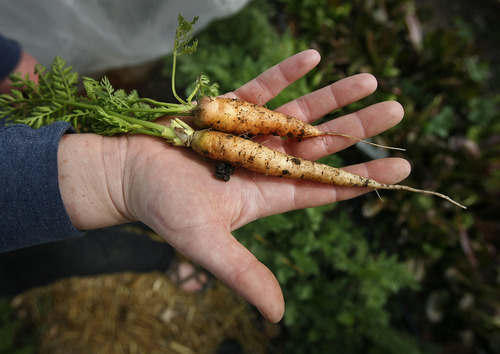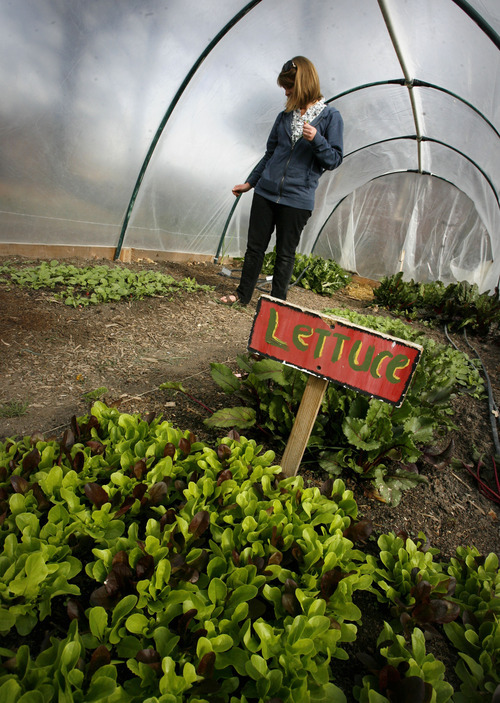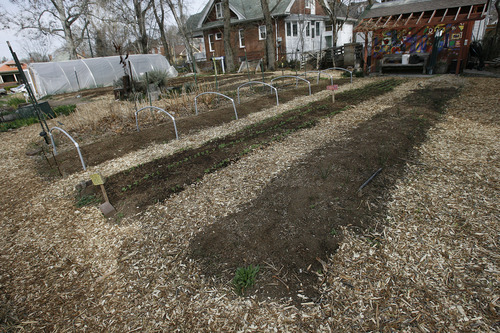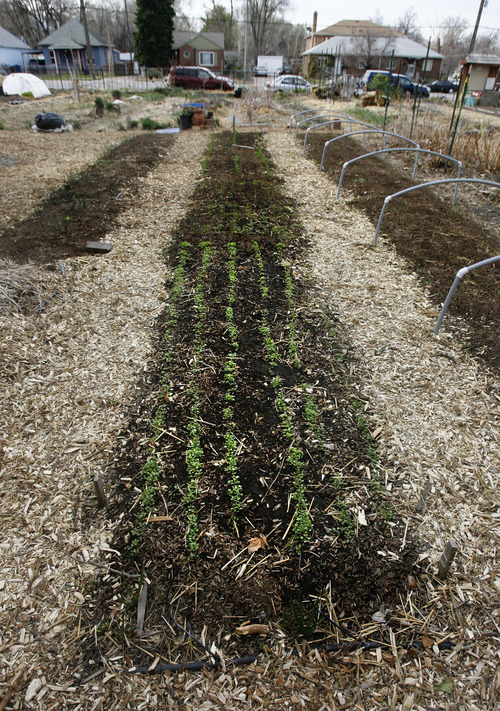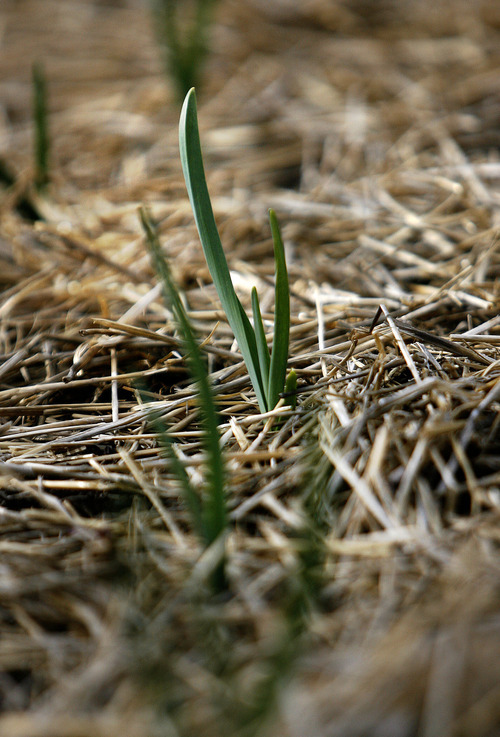This is an archived article that was published on sltrib.com in 2012, and information in the article may be outdated. It is provided only for personal research purposes and may not be reprinted.
With spring comes everything new, tender, wet and green. Small wonder, then, that with the first glorious signs of the season, many of us rush to plant. We buy our packets of seeds and 2-inch-tall starts in a manic frenzy, and during the first truly sunny day of the growing season, we haphazardly toss those babies into the ground, believing that as long as they're in, we're set.
We suggest taking a different tactic this year.
As anybody who's lived here for a while knows, spring in Utah is famously unreliable. So instead of sitting on your hands for the next six weeks waiting for perfect — consistent — planting weather, why not use this time to create a bona fide plan for this year's garden? Creating a garden map will help you stay focused when you're giddily overcome by flats of hardy little veggies, and it will also help you make the best use of your garden space.
Gardeners are "not necessarily thinking about what their long-term plans are" for the produce they grow, says Carly Gillespie, community educator for Wasatch Community Gardens. So one of the benefits of creating a map is that you'll be "much less likely to spontaneously buy plants."
—
Consider options • So, first thing first: Ask yourself what kinds of produce you and your family like to eat. While there's nothing wrong with planting vegetables for the sheer pleasure of seeing them grow, you'll find your dirt-encrusted labor of love more satisfying if you dream of heaping platefuls of juicy, sun-warmed tomatoes — and then you get to eat them.
After considering all the possibilities, create a wish list of everything you'd like to grow this year. Begin with general types of vegetables, and then subdivide that list into specific varieties. Some do better in Utah than others, so before you plant you may wish to do a little research on which varieties are recommended. (One helpful site: garden.usu.edu).
After making your vegetable wish list, measure the length and width of your vegetable patch and, using these dimensions, sketch your garden plot to scale. Graph paper will be just fine, although many digital drawing tools are also available, if you prefer.
When drawing your garden, be precise about its size and shape, and indicate where north, south, east and west are in relation to your planter beds. Making your drawing as large as possible, while still maintaining accurate proportions, will make it easier to envision your abundant, plant-filled garden.
—
Location, location, location • To determine the ideal location for each plant in your garden, you will need to know how big, on average, each of them will be when mature. You'll find this information on the backs of seed packets and on the tags provided with transplants.
List your plants from largest to smallest and then draw them, to scale, on your garden map. As a general rule of thumb, you will want to place the tallest, widest plants at the northernmost end of your garden bed, and the smallest, squattest plants at the southernmost end. This way, the tall plants won't shade the small plants as the sun makes its way across the sky.
Regardless of type, all vegetables require at least six to eight hours of full sun per day (eight to 10 is ideal).
There are two basic categories of vegetable crops: those that grow best between 55 degrees and 75 degrees (cool-season crops), and those that grow best when the average temperature is above 75 degrees (warm-season crops). The types of vegetables that you choose to grow will directly affect your garden design.
For example, if you have a mix of frost-hardy and warm-season vegetables on your list, a cold-tolerant, short-season crop (like spinach) can be planted in a certain location in late March and then, after you harvest that crop, the same location can be used to plant a warm-season vegetable (like peppers) in late May. Your garden plan can reflect this space-saving strategy.
—
Planning for success • As you become more comfortable with mapping your garden, you will inevitably discover that some garden designs work better for you than others. Creating a plan on paper before you ever set a plant outside gives you the freedom to experiment with different locations for vegetables in your garden without having to physically dig them up and move them from place to place. And it can be used later in the season to record ideas for next year's garden.
"It is difficult to track factors that can spell the difference between success and failure in a garden, such as crop rotations, fertilizer applications and weed- and insect- control measures, unless these factors are plotted on a garden map," says Stuart Parkinson, Franklin County, Idaho, extension educator.
Just a little planning can go a long way toward setting you up to be successful year after year, ensuring that the energy you give to your garden will be repaid in the edibles your garden gives to you.
facebook.com/nowsaltlake —
More garden planning tips
Multiplying the dimensions (length and width) of your garden will give you its square footage, which will help you decide which plants you can realistically grow in your plot.
When determining how much space each vegetable requires to grow to its optimal size, you will need to take both its height (how tall the plant will grow) and its spread (how wide the plant will grow) into account.
If your wish list contains many plants of the same species, you need to be mindful of the fact that different varieties of the same plant (like summer squashes and pumpkins) will readily cross-pollinate, and that sufficient space between plants will help you avoid cross-pollination (a particular concern if you are trying to maintain the purity of an heirloom vegetable).
By rotating the location of your plants from year to year, your soil and plants will both benefit. Good crop-rotation practices lessen the probability of exposing your plants to soil-borne pathogens and return essential nutrients to the soil. —
More garden planning tips
Multiplying the dimensions (length and width) of your garden will give you its square footage, which will help you decide which plants you can realistically grow in your plot.
When determining how much space each vegetable requires to grow to its optimal size, you will need to take both its height (how tall the plant will grow) and its spread (how wide the plant will grow) into account.
If your wish list contains many plants of the same species, you need to be mindful of the fact that different varieties of the same plant (like summer squashes and pumpkins) will readily cross-pollinate, and that sufficient space between plants will help you avoid cross-pollination (a particular concern if you are trying to maintain the purity of an heirloom vegetable).
By rotating the location of your plants from year to year, your soil and plants will both benefit. Good crop-rotation practices lessen the probability of exposing your plants to soil-borne pathogens and return essential nutrients to the soil. —
Gardening classes
Cool season garden tour
Spend a morning visiting and learning from experienced gardeners who grow cool weather crops. Participants will see how hoop houses, cold frames and other weather-modifying methods help extend the growing season. The class will include a discussion of what's best to plant and how to maximize production. Sponsored by Lifelong Learning at the University of Utah
When •Saturday, March 31, 10 a.m. to 1 p.m.
Where •Class will meet at the U. Annex buildings, in front of A wing. Carpool to garden locations.
Cost •$35
Register • continue.utah.edu/lifelong
Growing fruits and berries
Join Wasatch Community Gardens and Tree Utah for a lesson on growing berries and fruit trees.
When •Saturday, March 31, 2 to 4 p.m.
Where • Day-Riverside Library, Tree Utah's Eco Garden, 1575 W 1000 North
Cost • $15
Register • wasatchgardens.org or 801-359-2658
Landscape design
A four-week course that covers the basics of landscape design, including making a plan and selecting plants. Sponsored by Utah State University Weber County Extension. Deadline to register is Friday, March 30.
Where • Ogden Botanical Gardens, 1750 Monroe Boulevard.
When •Wednesdays, April 4-25, 10 a.m. to noon
Cost • $84 for garden members; $99 non-members
Register • http://www.extension.usu.edu
Vegetable gardening basics
Learn how to grow vegetables during this two-week class. Experts will talk about improving the soil, composting, cool- and warm-season crops, planting dates and ways to grow vegetables all year.
When •Mondays, April 2 and 9, 6:30 p.m.- 8:30 p.m., Monday, April 9 from 6:30 p.m.-8:30 p.m.
Where • University of Utah Continuing Education Annex, 1901 E. South Campus Dr, Salt Lake City
Cost • $114
Register • Call 801 587-5433 or visit continue.utah.edu.
Square Foot gardening
Learn everything you need to know about this simple and easy system of backyard gardening, including how to save space, water and work. Construction, soil, planting, harvesting and more.
When • Tuesday, April 3, 6 to 8 p.m.
Where •Thanksgiving Point Garden, 3001 Thanksgiving Way, Lehi.
Cost •$25
Register • http://www.thanksgivingpoint.org
Irrigation basics
Chris Madsen, a local irrigation specialist, will share practices that give plants the water in the most efficient way possible. This two-week course covers maintenance of existing irrigation systems and converting to drip and spray heads when appropriate and other key topics. Co-sponsored by Lifelong Learning.
When • Tuesdays, April 3 and 10, 6 to 8 p.m.
Where • Red Butte Gardens, 300 Wakara Way, Salt Lake City
Cost • $48 for members; $52 for non-members
Details • 801-587-5433 or redbuttegarden.org


